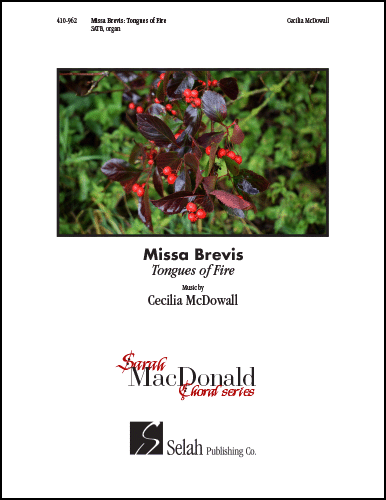|
Composer
Cecilia McDowall
Voicing SATB, organ
Topics Mass setting
Lectionary usage Pentecost ABC
Price $5.25 (U.S.)
Length 17' 15" Released 1/2020
Catalog no. 410-962
Difficulty Difficult
Series Sarah MacDonald Choral Series |
Order now!
Order PDF download!
Min. of 5
Description
This powerful Latin setting of the Mass Ordinary was commissioned for the 2013 London Festival of Contemporary Church Music. The "tongues of fire" subtitle refers to the Pentecost narrative from the book of Acts, a setting of which (Linguae Ignis) appears as a narrative motet movement. While the overall character and theme of the work makes it well-suited to Pentecost, the Ordinary movements could be programmed at other times in the church year.
Kyrie 2' 20"
Gloria 4' 15" 
Linguae Ignis (Tongues of Fire) 3' 00"
Sanctus 2' 10" 
Benedictus 2' 30"
Agnus Dei 3' 00" 
|
|


Review
"The largest work included in this packet is McDowall's mass setting originally from 2000 and appearing here in a revised form from 2013. As typical for a missa brevis, the Credo is omitted; however, McDowall includes a noncanonical movement entitled Linguae Ignis, a setting in Latin of Acts 2:2-4 depicting the tongues of fire resting on the heads of the apostles on the day of Pentecost. This movement ties the mass to a particular feast day, although excluding this section would do little damage to the musical integrity of the work. Conversely, this movement could be excerpted from the larger work for use as a motet on the day of Pentecost. The entire setting is full of fire, as its subtitle would suggest, and the score contains many dazzling effects for both voices and organ. Characteristic of McDowall’s compositional voice, the highly chromatic, sophisticated harmonic language creates its own sonic spectrum. Singers must acclimate to her style before melodic lines can feel natural and predictable. The rhythmic organization is similarly complex, requiring careful rehearsal as parts overlap and seemingly compete with each other at times. The organ score provides an excellent vehicle to display the colors of a fine instrument, with evocative solo lines and many coloristic possibilities, yet the part does not require a virtuoso player. The soprano line divides so frequently, and for such prolonged passages, that the work could nearly be classified as a five-voice setting. Lower voices, however, never divide, and advanced choirs of even modest size would suffice for performance." -AAM Journal, March 2020 |



